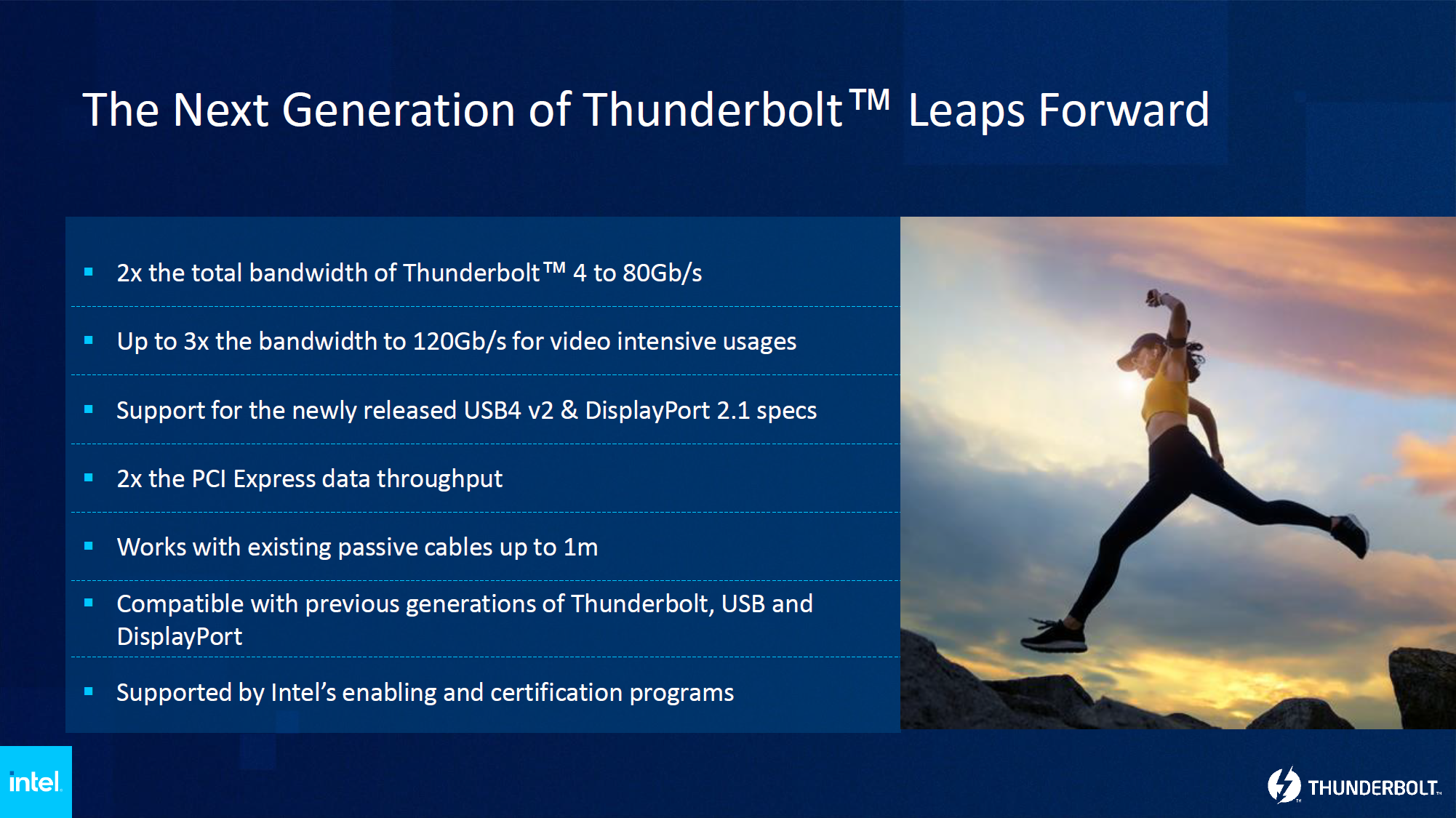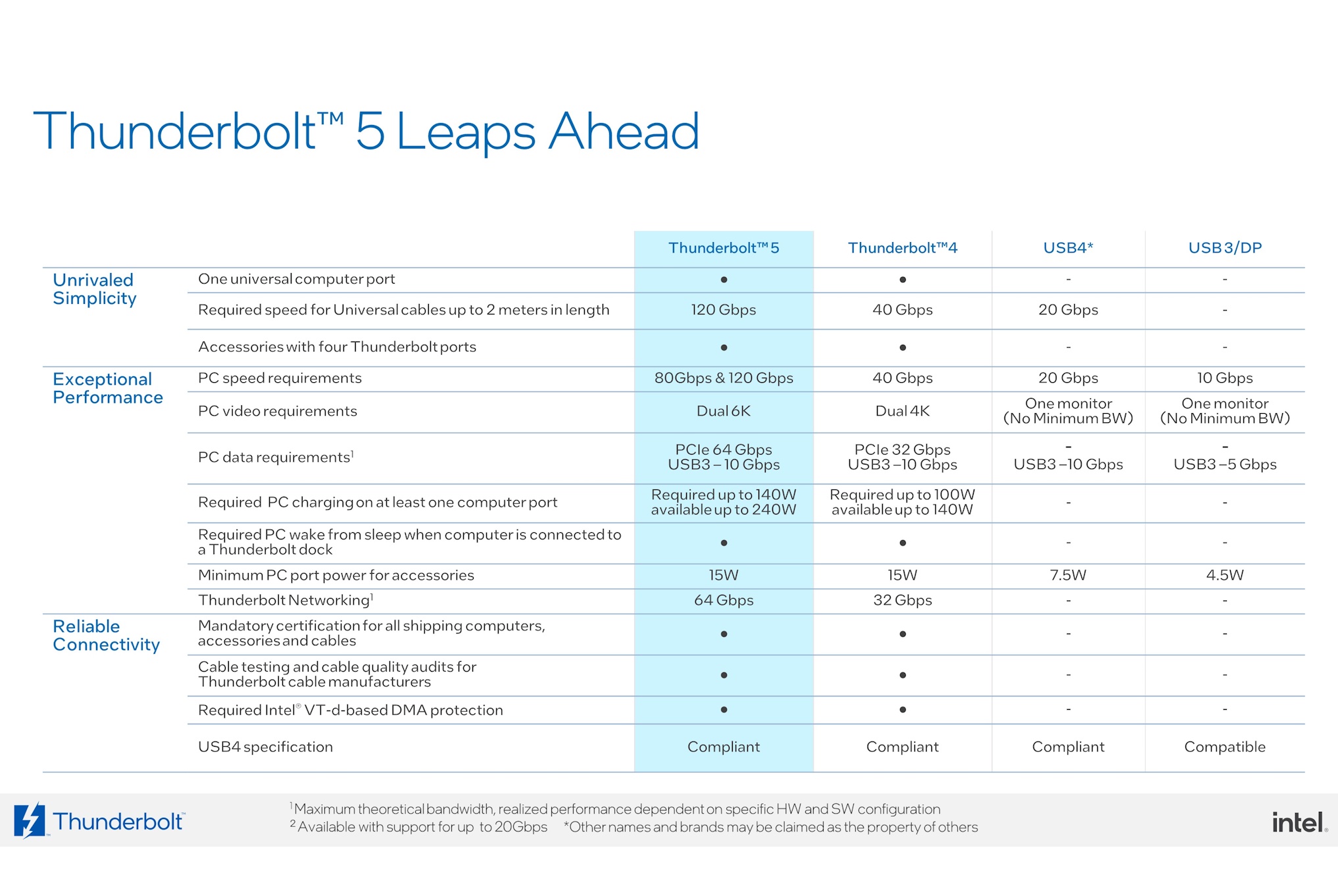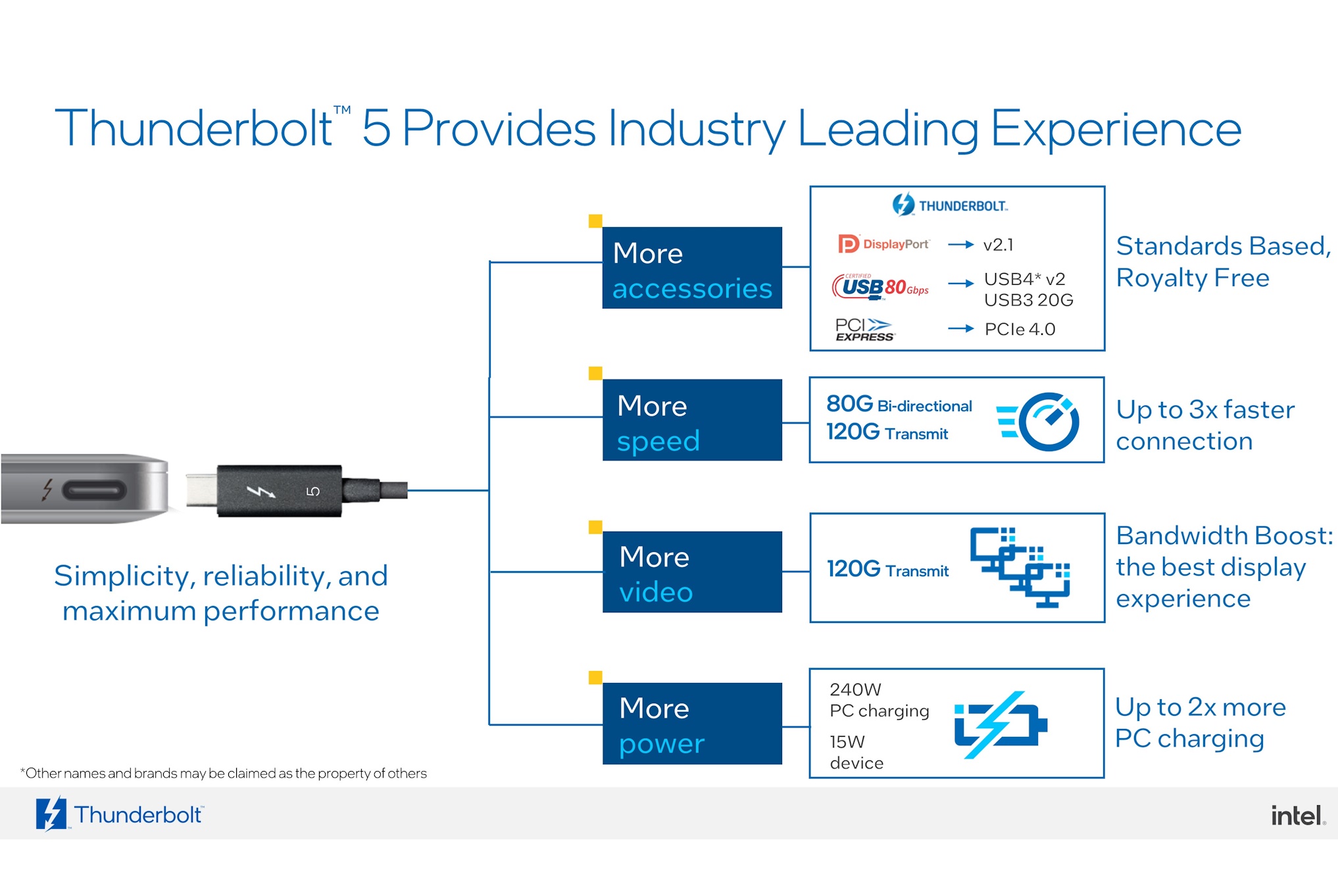Intel Unveils Barlow Ridge Thunderbolt 5 Controllers - TB5 Launching In 2024
by Ganesh T S on September 12, 2023 9:00 AM EST- Posted in
- Intel
- Thunderbolt
- Thunderbolt 5
- USB4 v2

The USB-IF and VESA released the specifications of USB4 v2 and DisplayPort 2.1 in Q4 2022. At that time, Intel also announced that their next-gen Thunderbolt specifications would build upon these standards. However, concrete details were not divulged. Today, the company is unveiling Thunderbolt 5 officially with discrete controllers in tow for both hosts and peripherals.
Thunderbolt 5: Technical Details
The USB4 v2 specifications have been public for almost a year now. As a result, the capabilities of Thunderbolt 5 on the technical front are not much of a secret. In fact, Intel had detailed most of them last year.
The technical aspects described above include:
- PCIe Gen4 x4 support (64 Gbps full duplex)
- DisplayPort 2.1 support (up to 80 Gbps)
- Asymmetric operation (120 Gbps transmit / 40 Gbps receive), in addition to the regular 80 Gbps transmit / 80 Gbps receive
- Usage of PAM3 (Pulse Amplitude Modulation with three levels) enabling more data transfer in each clock cycle
A few additional details were provided as part of today's announcement. These are in addition to Thunderbolt 4 features.
- Compulsory requirement to support dual 6K monitors
- Compulsory 140W PD support for charging, up to 240W optional
- Doubled Thunderbolt networking bandwidth (from 10 Gbps full duplex to 20 Gbps full duplex)
- Existing Thunderbolt 3 cables up to 1m can also support the new speeds
Thunderbolt 5 also supports up to 240W power delivery (USB-PD EPR specifications). This is useful for gaming notebooks and other power-hungry systems connecting to a Thunderbolt 5 dock (and relying on it as a power source). However, this is an optional feature and is likely to be relegated to premium Thunderbolt 5 peripherals. The compulsory features related to the increase in available bandwidth translate to support for high-refresh rate high-resolution monitors, and support for external SSDs and eGFX with PCIe Gen4 x4 links.
The Barlow Ridge Thunderbolt 5 Controller Family
Intel is bringing Thunderbolt 5 to the market with discrete silicon first. The Barlow Ridge family includes controllers for both hosts and accessories. Silicon meant for accessories are equipped with one upstream and three downstream Thunderbolt 5 ports. For computers, the controller takes in a DisplayPort 2.1 input along with a PCIe Gen4 x4 link to interface with the host.
The technical aspects of Barlow Ridge such as package size and TDP will be made public in the coming months. Intel expects Thunderbolt 5-equipped computers and accessories to launch in 2024. Technical collateral and other developer resources will become available in Q4 2023.
Based on the Thunderbolt 5 details presented today, it is clear that Thunderbolt ports will continue to remain the Type-C port that does it all. We would have liked some of the optional features (such as USB3 20G support) to become compulsory, but the other exciting updates in Thunderbolt 5 may make it easy for consumers to look past that. In any case, we have seen recent USB4 / Thunderbolt 4 implementations supporting that standard, so it is likely that at least some Thunderbolt 5 host ports will also support that standard.
Source: Intel



















22 Comments
View All Comments
dontlistentome - Tuesday, September 12, 2023 - link
20G USB3 support being mandated would reduce the bandwidth elsewhere. On TB3, fast USB3 support kill PCI/Displayport lanes. It would be the same here.Otherwise, nice update, but not a huge leap over TB3 which is now 7 years old.
Samus - Tuesday, September 12, 2023 - link
I agree it is underwhelming, definitely an evolutionary update over TB3, but that appears by design as they kept compatibility with previous cables (which isn't a big deal but definitely helps sneak in adoptability.)The asymmetric operation, however, is pretty substantial for the niche market that can use it, and impressive they are able to perform that over previous cables because it would mean one TX and RX are next to each other, as typical symmetric operation has the RX and TX segmented from one another for obvious reasons. There is clearly some very tight signaling or impressive error correction going on here.
MegasChara - Monday, September 18, 2023 - link
"There is clearly some very tight signaling or impressive error correction going on here."Both.
https://www.synopsys.com/designware-ip/technical-b...
KimGitz - Tuesday, September 12, 2023 - link
Finally. Now we can have eGPU performance viable.Will MeteorLake feature Thunderbolt 5?
240W is enough for gaming.
NextGen_Gamer - Tuesday, September 12, 2023 - link
Meteor Lake definitely won't have TB5, at least not at launch, which is supposed to be October 2023. Intel won't even be sending over the final specs to developers/OEMs until Q4 2023, and then actual shipping silicon and products probably in late summer 2024 (as a guess). By that point in time, it makes more sense to ship new products with TB5 based on the next platform Arrow Lake instead of refreshing any older Meteor Lake ones.KimGitz - Saturday, September 16, 2023 - link
It is a disappointing. I'd rather wait for Arrow Lake since my experience with discrete controllers is not good.Sonic01 - Tuesday, September 12, 2023 - link
No it won't Meteor Lake is basically finished already (it's released in 8 days) and this announcement says expect products in 2024, so no, no TB5 in this years chip released. Arrow Lake will prob come with it this time next year.Also, TB3 only throttles current cards by like 5-10%.
KimGitz - Saturday, September 16, 2023 - link
I think the difference is enough to want TB5 over TB4 for eGPUs. I have watched comparison between OCuLink and Thunderbolt 4 and there is a worthwhile differenceeddman - Tuesday, September 12, 2023 - link
I've been out of the loop. How do they get 120 Gbps if there are only 4 PCIe 4 lanes, capable of 64 Gbps?evilspoons - Tuesday, September 12, 2023 - link
The system can switch from two lanes upload, two lanes download into three lanes/ one lane. You go from 80+80 to 120+40.The bandwidth total is PCI Express and DP, it's not just the PCIe lanes being counted.